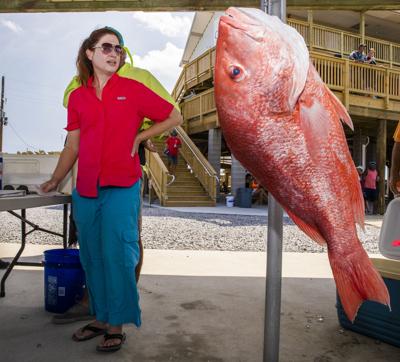April 15 — yech, tax day! — but there's more to that day this year.
Red snapper season opens for thousands of Louisiana’s recreational fishermen, fisherwomen and fisherchildren.
It’s eight days away. Hopefully you’ll be ready, and hope this March-into-April wind cycle lays down enough to make for comfortable trips.
Yes, April 15, an opening day some six weeks earlier since those first nightmarish years when federal regulations imposed much-reduced seasons and creel limits.
We’re starting with a four-fish-a-day limit, and the season is open all year until state fisheries managers determine we’re reached our Louisiana allotment of 934,587 pounds.
There are other regulations you must know to take to Louisiana’s offshore waters to pursue this wonderfully delicious fish.
1. A recreationally caught red snapper must measure at least 16 inches long to be a “keeper.”
2. Know your species, notably the difference between a red snapper and a blackfin snapper. They look alike except the blackfin snapper has a large black spot at its pectoral fins. This year’s state-management limit is four red snapper, but you can keep as many as 10 blackfin snapper in an aggregate. Go to the Gulf Council website — gulfcouncil.org — to find all the size and creel limits for snapper and other reef fish.
3. A new regulation went into effect Jan. 2022 requiring all commercial and recreational boats “to have a venting tool or descending device rigged and ready to use when fishing for reef fish in Gulf of Mexico federal waters.” Other rules demand the use of non-stainless steel hooks and the use of dehooking tools.
Return ’em Right, based in Florida, has release devices for recreational fishermen and videos on how to properly release reef fish. You can search for the group’s website for all the details.
4. Recreational offshore fishermen targeting red snapper and other reef fish must have a fee-free Recreational Offshore Landing Permit along with, if age requires, state basic and saltwater fishing licenses.
You can get permit from the Wildlife and Fisheries website: wlf.louisiana.gov.
When registered, you can save an electronic copy on your mobile phone or print a copy. You must carry it along with the licenses on your person on your offshore trip.
If you’re on a chartered trip, only the charter skipper needs to have the ROLP, and make sure your charter skipper will be allowed to fish in state waters. Some charters have federal permits which allow them to fish only in federal waters.
And, if you’re planning to fish in Alabama, know that state’s red snapper season opens May 24 with Friday-through-Monday seasons and a two-fish daily limit with a 16-inch minimum size limit.
The commission
An odd 3 p.m. time is set for Tuesday’s Wildlife and Fisheries Commission at state Wildlife and Fisheries headquarters, 2000 Quail Drive in Baton Rouge.
Top agenda items are to receive public comment, propose amendments and finalize the dates and regulations for a 2024 black bear hunting season, and to take the last step to finalize the 2024-2025 hunting seasons.
The meeting will have a live audio/video broadcast via Zoom.
ALAS scholarships
It’s amazing how many north Louisiana schools have taken to the Archery in Louisiana Schools — ALAS — over the years, and south Louisiana schools don’t appear to want to participate.
Maybe that will change now that scholarship money is available.
Just ask Zoe Bayne, the Haughton High School teen who was named the 2024 Shooter of the Year. She, along with 31 other students, shared in $17,000 worth of scholarships and gift cards after competing in the State Bullseye Tournament held in late March in Alexandria.
Wildlife and Fisheries program manager Chad Moore said a $15,000 National Archery in Schools Program grant meant $30,000 in scholarships were awarded in ALAS competitors this year.
For more, go to this website: wlf.louisiana.gov/page/alas
Upping the reward
The reward for information leading to the conviction of person or persons involved in killing a whooping crane is up to $15,000. The crane was found near Mamou.

